A perfect leftsided binary tree is a binary tree where every
A perfect left-sided binary tree is a binary tree where every internal node has two children, and every left child is a leaf. Write an algorithm, based on DFS or BFS, that takes as input an undirected graph G, and returns whether or not G is (or can be viewed as) a perfect left-sided binary tree. Analyze the time complexity of your algorithm.
Solution
bfs(G)
{
list L = empty
tree T = empty
choose a starting vertex x
search(x)
while(L nonempty)
remove edge (v,w) from start of L
if w not yet visited
{
add (v,w) to T
search(w)
}
}
dfs(G)
{
list L = empty
tree T = empty
choose a starting vertex x
search(x)
while(L nonempty)
remove edge (v,w) from end of L
if w not yet visited
{
add (v,w) to T
search(w)
}
}
search(vertex v)
{
visit(v);
for each edge (v,w)
add edge (v,w) to end of L
}
mport java.util.*;
public class BST <T extends Comparable<T>> implements Iterable<T>
{
public static void main(String[] args)
{
Integer[] a = {1,5,2,7,4};
BST<Integer> bst = new BST<Integer>();
for(Integer n : a) bst.insert(n);
bst.preOrderTraversal();
System.out.println();
//testing comparator
//build a mirror BST with a rule: Left > Parent > Right
//code for the comparator at the bottom of the file
bst = new BST<Integer>(new MyComp1());
for(Integer n : a) bst.insert(n);
bst.preOrderTraversal();
System.out.println();
bst.inOrderTraversal();
System.out.println();
for(Integer n : bst) System.out.print(n);
System.out.println();
System.out.println(bst);
//testing restoring a tree from two given traversals
bst.restore(new Integer[] {11,8,6,4,7,10,19,43,31,29,37,49},
new Integer[] {4,6,7,8,10,11,19,29,31,37,43,49});
bst.preOrderTraversal();
System.out.println();
bst.inOrderTraversal();
System.out.println();
//testing diameter
System.out.println(\"diameter = \" + bst.diameter());
//testing width
System.out.println(\"width = \" + bst.width());
}
private Node<T> root;
private Comparator<T> comparator;
public BST()
{
root = null;
comparator = null;
}
public BST(Comparator<T> comp)
{
root = null;
comparator = comp;
}
private int compare(T x, T y)
{
if(comparator == null) return x.compareTo(y);
else
return comparator.compare(x,y);
}
/*****************************************************
*
* INSERT
*
******************************************************/
public void insert(T data)
{
root = insert(root, data);
}
private Node<T> insert(Node<T> p, T toInsert)
{
if (p == null)
return new Node<T>(toInsert);
if (compare(toInsert, p.data) == 0)
return p;
if (compare(toInsert, p.data) < 0)
p.left = insert(p.left, toInsert);
else
p.right = insert(p.right, toInsert);
return p;
}
/*****************************************************
*
* SEARCH
*
******************************************************/
public boolean search(T toSearch)
{
return search(root, toSearch);
}
private boolean search(Node<T> p, T toSearch)
{
if (p == null)
return false;
else
if (compare(toSearch, p.data) == 0)
return true;
else
if (compare(toSearch, p.data) < 0)
return search(p.left, toSearch);
else
return search(p.right, toSearch);
}
/*****************************************************
*
* DELETE
*
******************************************************/
public void delete(T toDelete)
{
root = delete(root, toDelete);
}
private Node<T> delete(Node<T> p, T toDelete)
{
if (p == null) throw new RuntimeException(\"cannot delete.\");
else
if (compare(toDelete, p.data) < 0)
p.left = delete (p.left, toDelete);
else
if (compare(toDelete, p.data) > 0)
p.right = delete (p.right, toDelete);
else
{
if (p.left == null) return p.right;
else
if (p.right == null) return p.left;
else
{
// get data from the rightmost node in the left subtree
p.data = retrieveData(p.left);
// delete the rightmost node in the left subtree
p.left = delete(p.left, p.data) ;
}
}
return p;
}
private T retrieveData(Node<T> p)
{
while (p.right != null) p = p.right;
return p.data;
}
/*************************************************
*
* toString
*
**************************************************/
public String toString()
{
StringBuffer sb = new StringBuffer();
for(T data : this) sb.append(data.toString());
return sb.toString();
}
/*************************************************
*
* TRAVERSAL
*
**************************************************/
public void preOrderTraversal()
{
preOrderHelper(root);
}
private void preOrderHelper(Node r)
{
if (r != null)
{
System.out.print(r+\" \");
preOrderHelper(r.left);
preOrderHelper(r.right);
}
}
public void inOrderTraversal()
{
inOrderHelper(root);
}
private void inOrderHelper(Node r)
{
if (r != null)
{
inOrderHelper(r.left);
System.out.print(r+\" \");
inOrderHelper(r.right);
}
}
/*************************************************
*
* CLONE
*
**************************************************/
public BST<T> clone()
{
BST<T> twin = null;
if(comparator == null)
twin = new BST<T>();
else
twin = new BST<T>(comparator);
twin.root = cloneHelper(root);
return twin;
}
private Node<T> cloneHelper(Node<T> p)
{
if(p == null)
return null;
else
return new Node<T>(p.data, cloneHelper(p.left), cloneHelper(p.right));
}
/*************************************************
*
* MISC
*
**************************************************/
public int height()
{
return height(root);
}
private int height(Node<T> p)
{
if(p == null) return -1;
else
return 1 + Math.max( height(p.left), height(p.right));
}
public int countLeaves()
{
return countLeaves(root);
}
private int countLeaves(Node<T> p)
{
if(p == null) return 0;
else
if(p.left == null && p.right == null) return 1;
else
return countLeaves(p.left) + countLeaves(p.right);
}
//This method restores a BST given preorder and inorder traversals
public void restore(T[] pre, T[] in)
{
root = restore(pre, 0, pre.length-1, in, 0, in.length-1);
}
private Node<T> restore(T[] pre, int preL, int preR, T[] in, int inL, int inR)
{
if(preL <= preR)
{
int count = 0;
//find the root in the inorder array
while(pre[preL] != in[inL + count]) count++;
Node<T> tmp = new Node<T>(pre[preL]);
tmp.left = restore(pre, preL+1, preL + count, in, inL, inL +count-1);
tmp.right = restore(pre, preL+count+1, preR, in, inL+count+1, inR);
return tmp;
}
else
return null;
}
//The width of a binary tree is the maximum number of elements on one level of the tree.
public int width()
{
int max = 0;
for(int k = 0; k <= height(); k++)
{
int tmp = width(root, k);
if(tmp > max) max = tmp;
}
return max;
}
//rerturns the number of node on a given level
public int width(Node<T> p, int depth)
{
if(p==null) return 0;
else
if(depth == 0) return 1;
else
return width(p.left, depth-1) + width(p.right, depth-1);
}
//The diameter of a tree is the number of nodes
//on the longest path between two leaves in the tree.
public int diameter()
{
return diameter(root);
}
private int diameter(Node<T> p)
{
if(p==null) return 0;
//the path goes through the root
int len1 = height(p.left) + height(p.right) +3;
//the path does not pass the root
int len2 = Math.max(diameter(p.left), diameter(p.right));
return Math.max(len1, len2);
}
/*****************************************************
*
* TREE ITERATOR
*
******************************************************/
public Iterator<T> iterator()
{
return new MyIterator();
}
//pre-order
private class MyIterator implements Iterator<T>
{
Stack<Node<T>> stk = new Stack<Node<T>>();
public MyIterator()
{
if(root != null) stk.push(root);
}
public boolean hasNext()
{
return !stk.isEmpty();
}
public T next()
{
Node<T> cur = stk.peek();
if(cur.left != null)
{
stk.push(cur.left);
}
else
{
Node<T> tmp = stk.pop();
while( tmp.right == null )
{
if(stk.isEmpty()) return cur.data;
tmp = stk.pop();
}
stk.push(tmp.right);
}
return cur.data;
}//end of next()
public void remove()
{
}
}//end of MyIterator
/*****************************************************
*
* the Node class
*
******************************************************/
private class Node<T>
{
private T data;
private Node<T> left, right;
public Node(T data, Node<T> l, Node<T> r)
{
left = l; right = r;
this.data = data;
}
public Node(T data)
{
this(data, null, null);
}
public String toString()
{
return data.toString();
}
} //end of Node
}//end of BST
class MyComp1 implements Comparator<Integer>
{
public int compare(Integer x, Integer y)
{
return y-x;
}
}
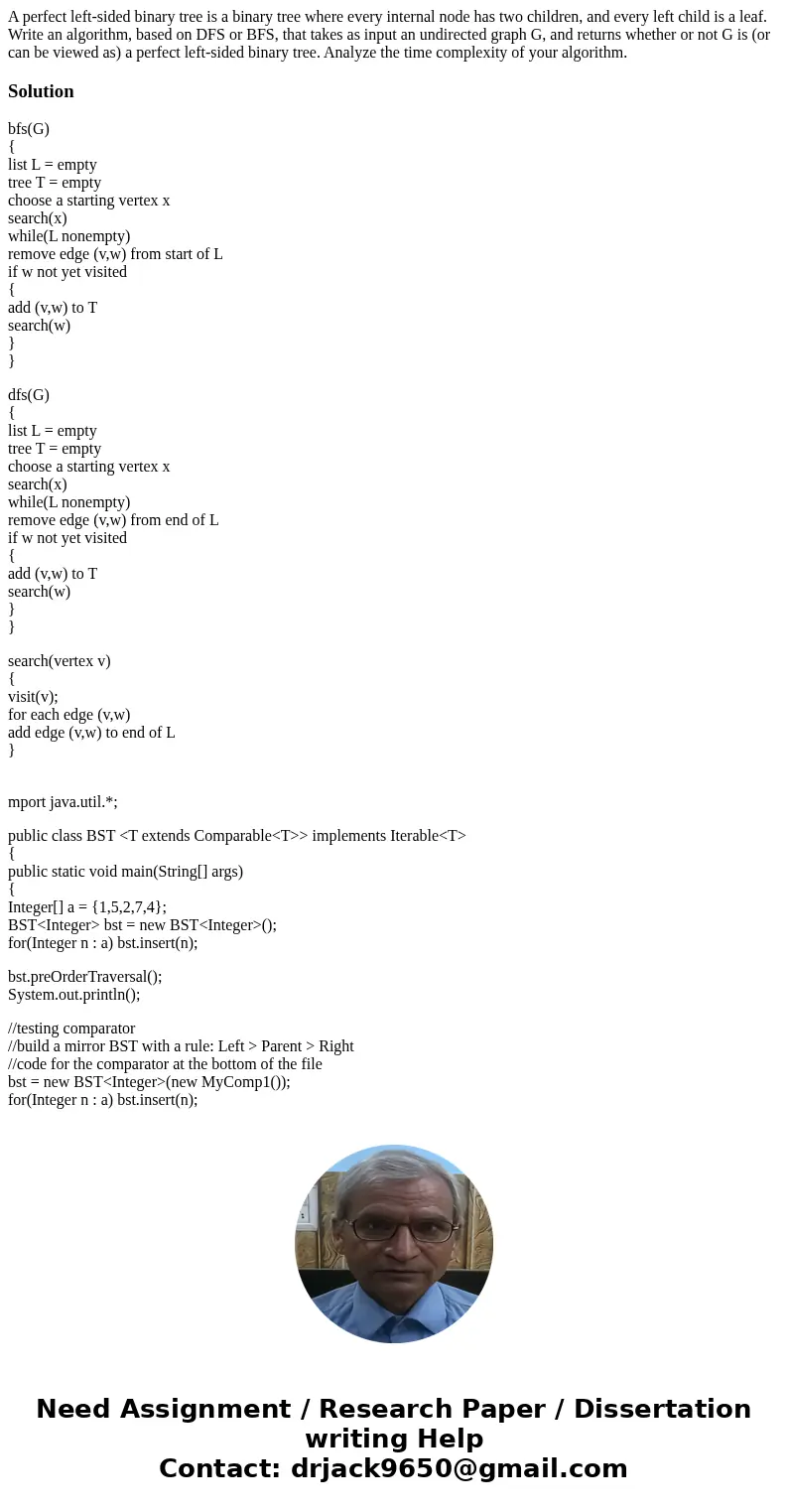
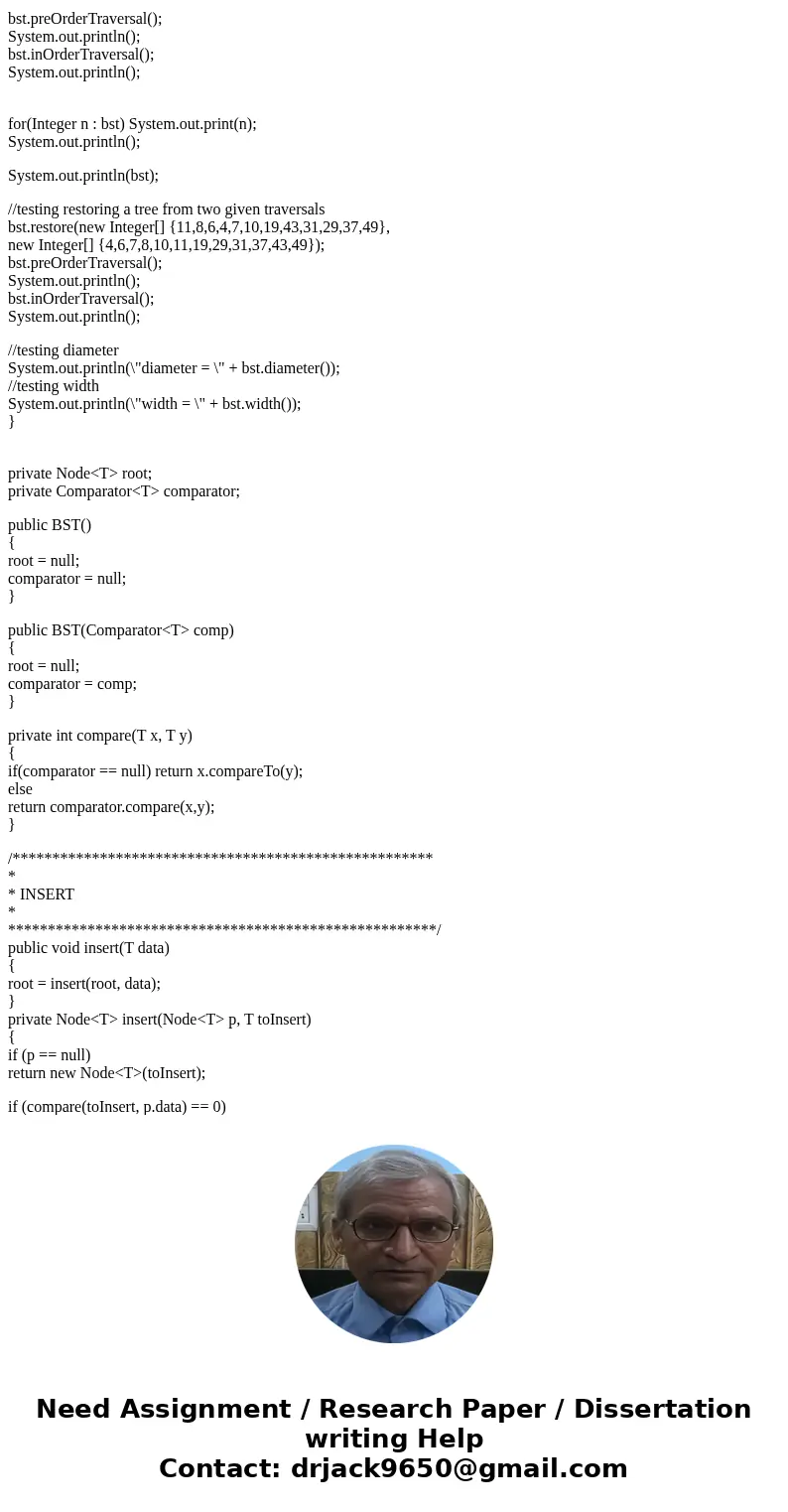
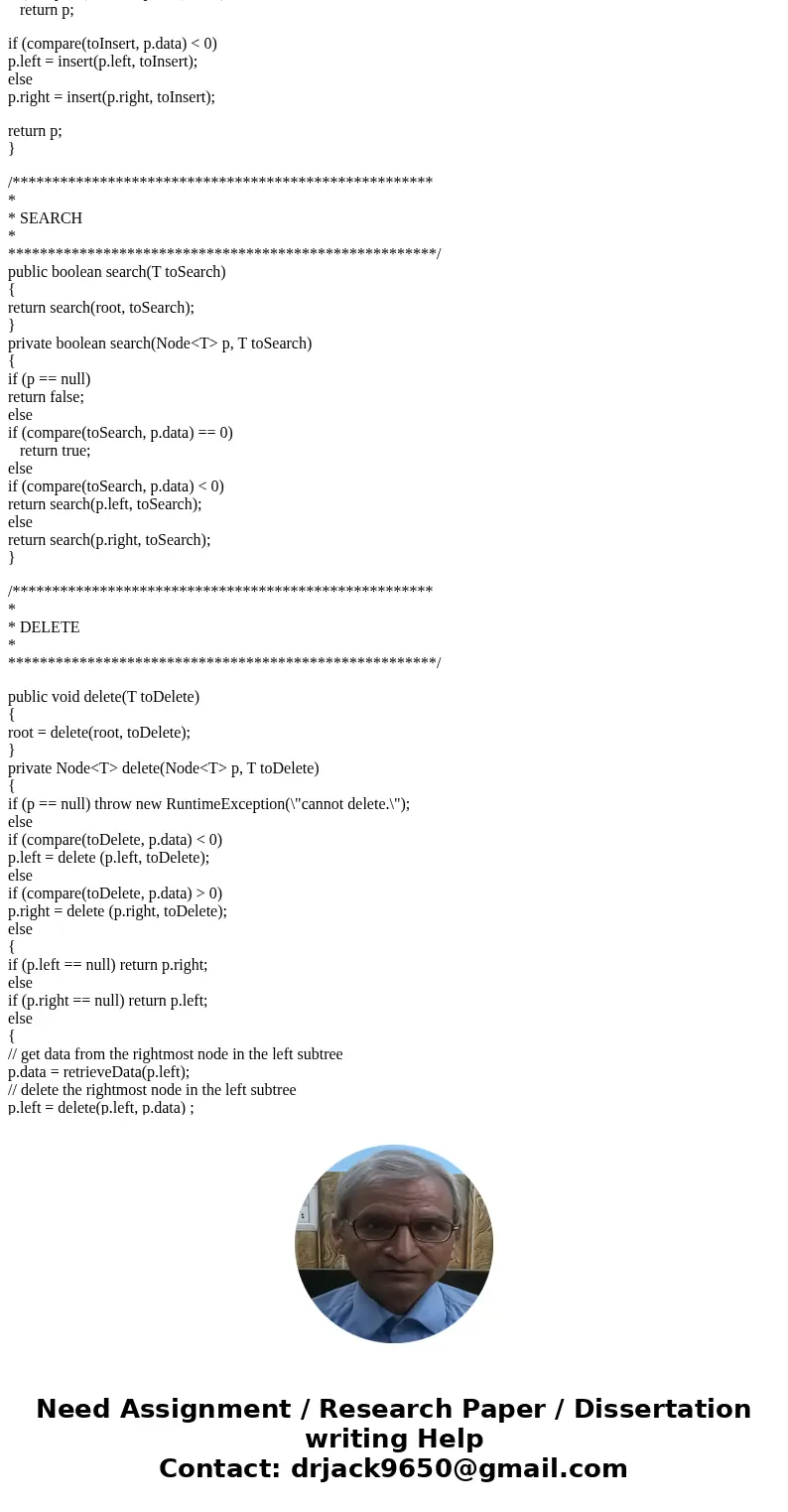
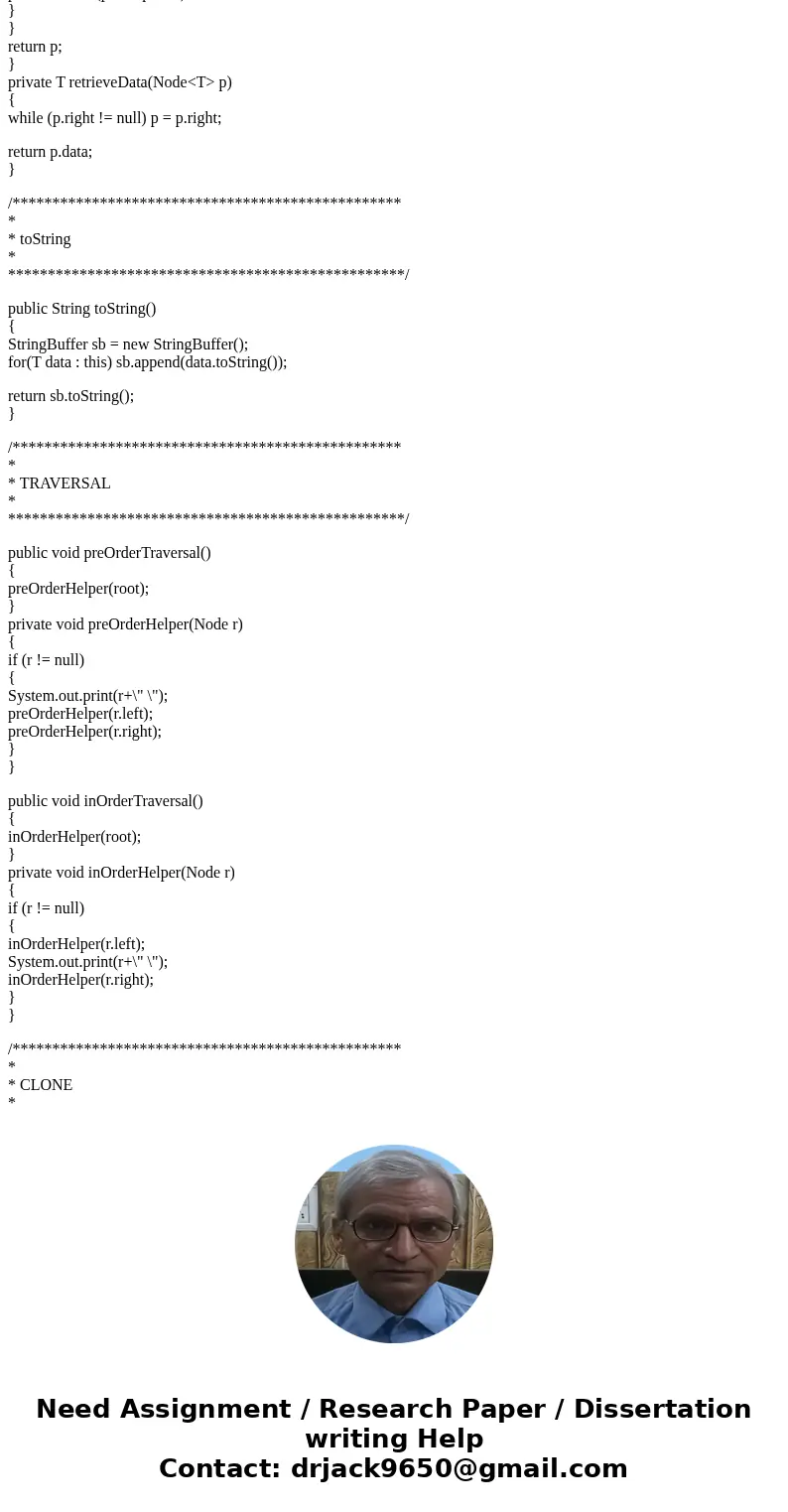
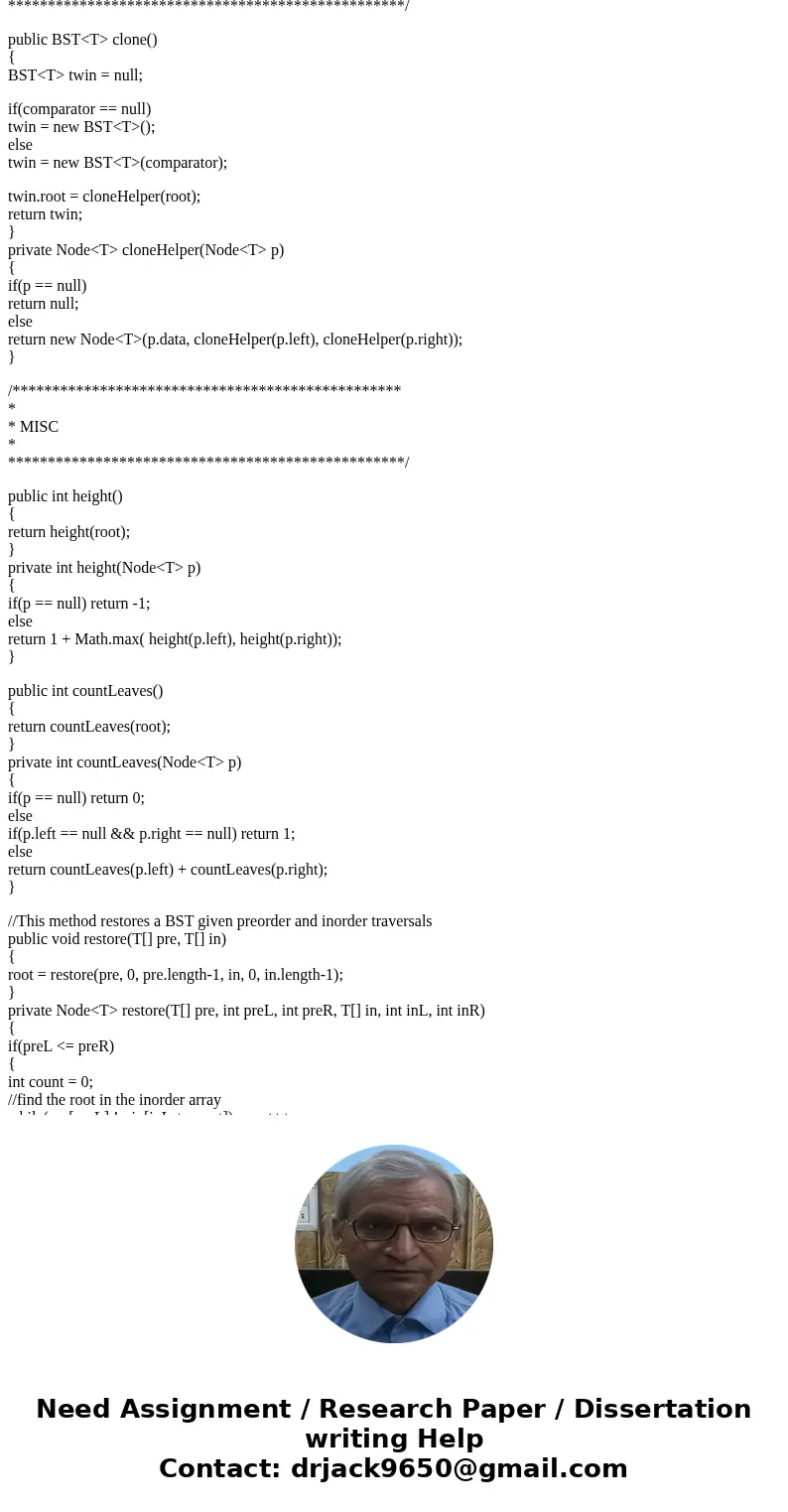
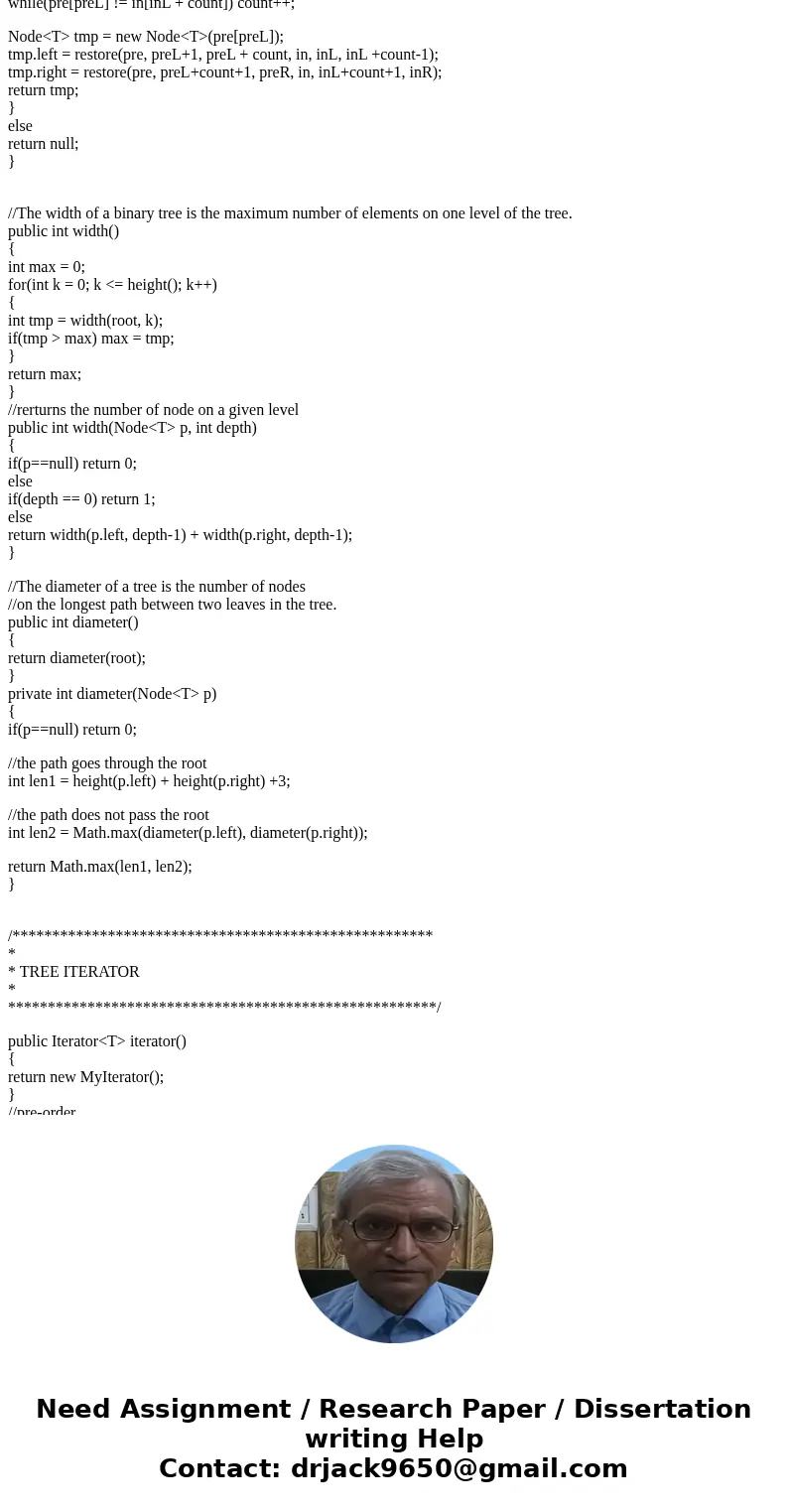
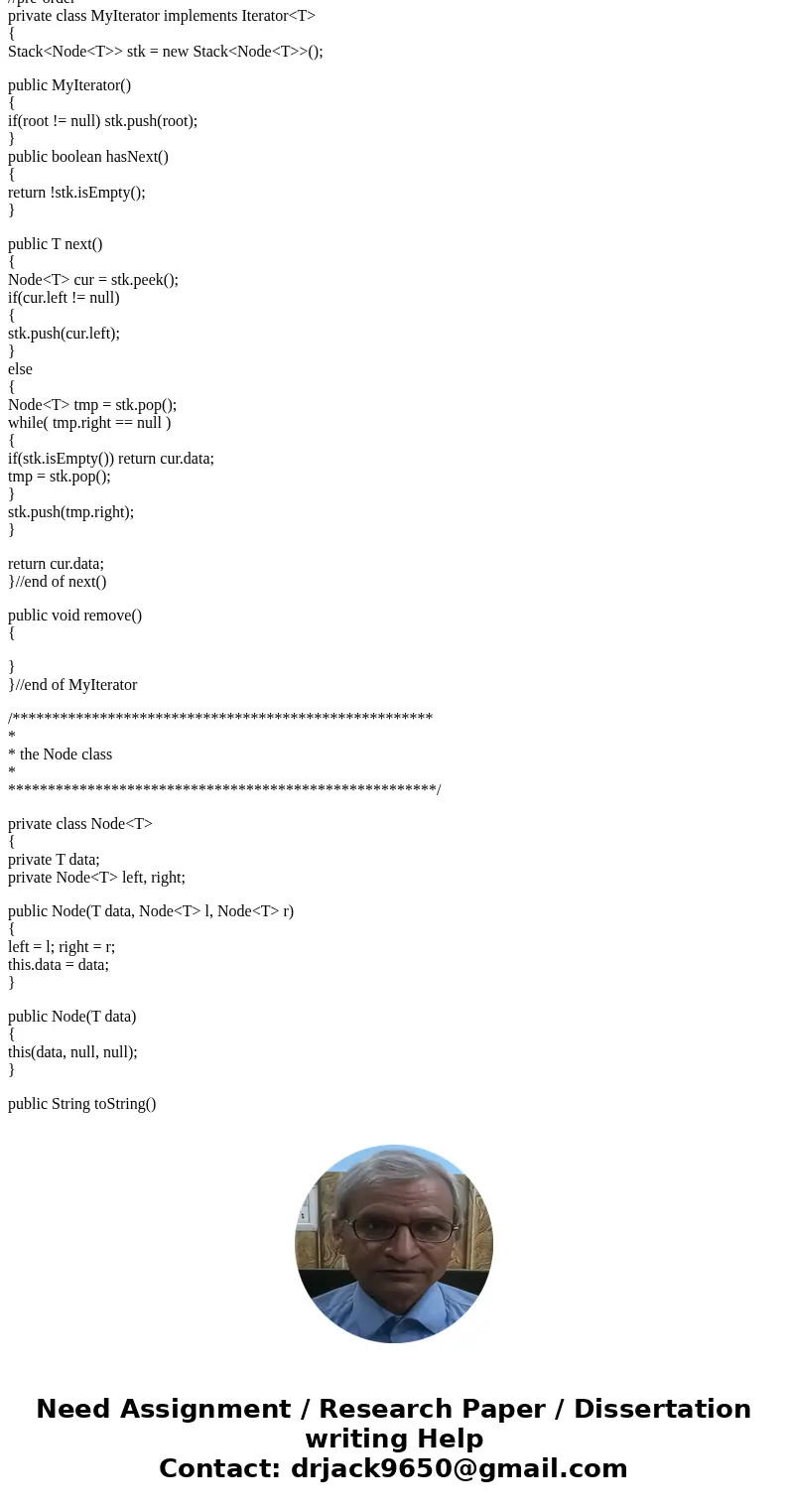
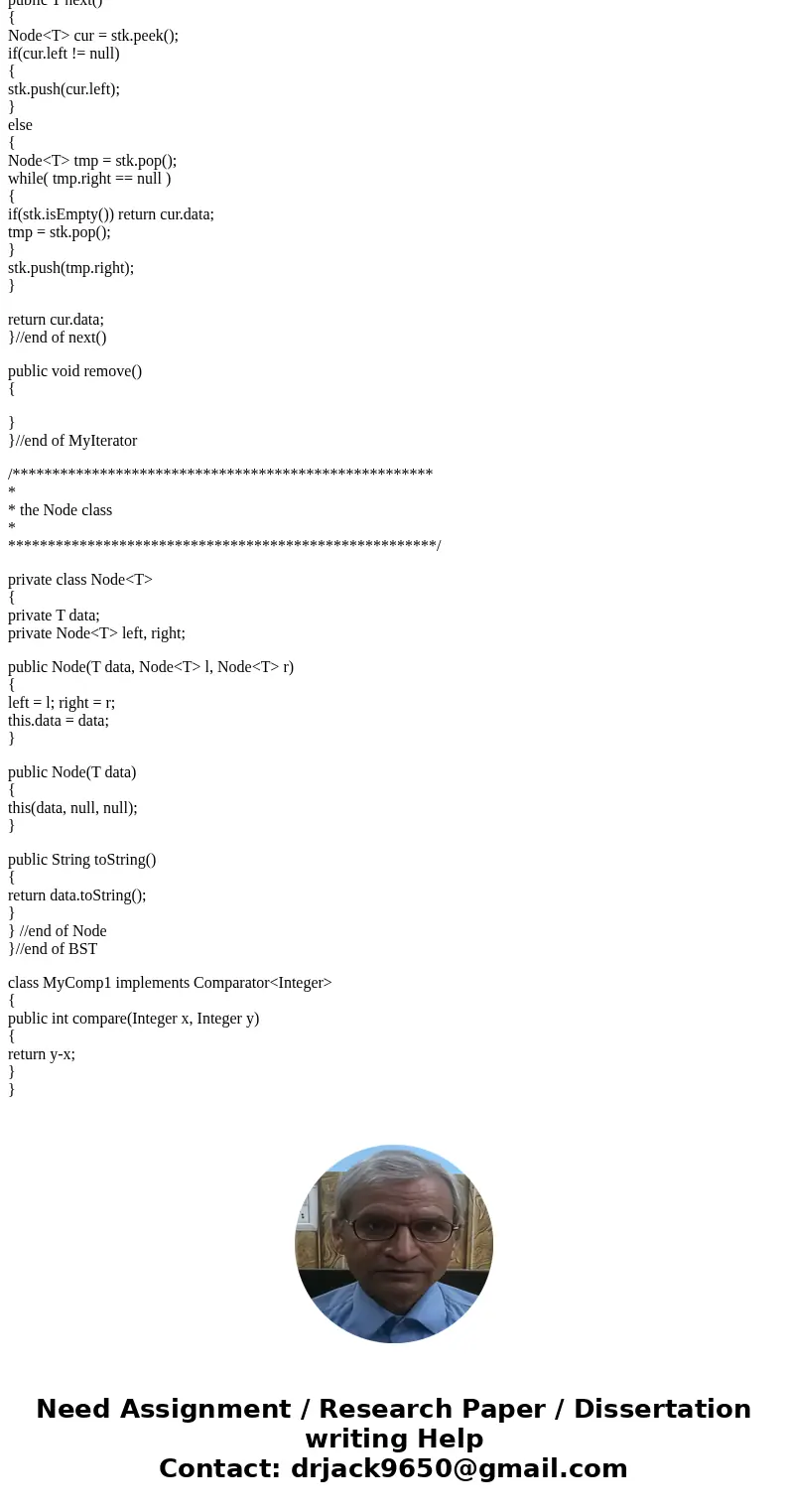
 Homework Sourse
Homework Sourse